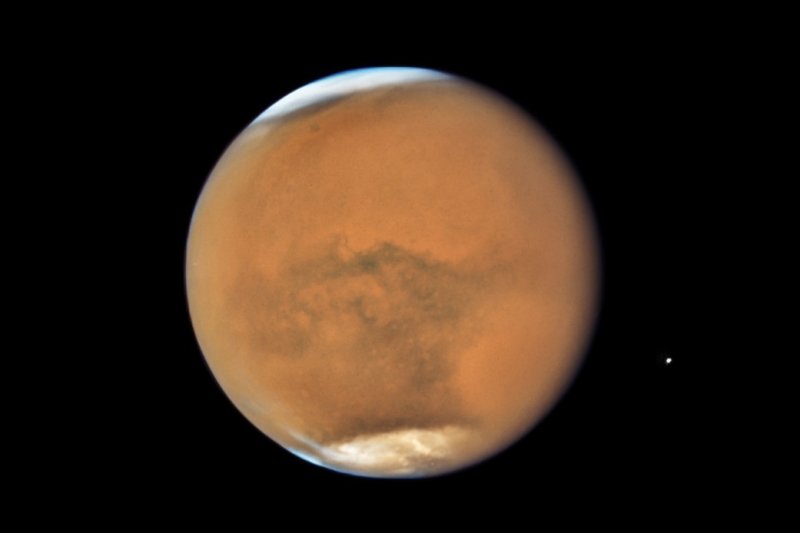According to new research, pictured in a 2003 image taken using NASA's Hubble Space Telescope Mars is too small to hold onto significant water reserves. File Photo by NASA/ESA/STScI
Sept. 20 (UPI) -- For a planet to be habitable, it must be able to hold significant amounts of liquid water.
When considering a planet's potential habitability, scientists mostly look at a planet's atmosphere and its distance from its host star. But novel research out of Washington University in St. Louis suggests size matters, too.
According to the new study, published Monday in the journal PNAS, Mars is too small to hold onto significant water reserves.
Satellites images and extensive modeling efforts suggest Mars once hosted significant amounts of water on its surface, including lakes, oceans and rivers.
Today, Mars' surface is quite dry. What water remains is mostly frozen, locked up in polar ice caps or hidden in the shadows of craters.
Through the years, planetary scientists have offered a variety of explanations for why Mars lost its atmosphere and ability to hold onto water. Some contend a weakening of Mars' magnetic field allowed the Red Planet's atmosphere to be easily stripped away by solar winds.
The latest analysis, however, suggests it wasn't anything that happened to Mars. The Red Planet was fated to lose its water -- ever since it stopped growing.
"There is likely a threshold on the size requirements of rocky planets to retain enough water to enable habitability and plate tectonics, with mass exceeding that of Mars," senior study author Kun Wang, assistant professor of earth and planetary sciences at Washington University, said in a press release.
For their analysis, researchers used stable isotopes of the element potassium as a barometer for estimating the abundance and distribution of volatile elements of various planetary bodies.
According to the research team, potassium, though only moderately volatile, tracks reliably with other more volatile elements.
First, scientists measured the potassium isotope compositions of Martian meteorites featuring bulk silicate, the material that forms most of Mars.
"Martian meteorites are the only samples available to us to study the chemical makeup of the bulk Mars," Wang said.
"Those Martian meteorites have ages varying from several hundred millions to 4 billion years and recorded Mars' volatile evolution history. Through measuring the isotopes of moderately volatile elements, such as potassium, we can infer the degree of volatile depletion of bulk planets and make comparisons between different solar system bodies," Wang said.
The analysis confirmed that during its formation, Mars lost more of its potassium and other volatiles than Earth did.
When scientists compared their findings to the results of a previously conducted survey of lunar rocks, they determined the moon lost even more potassium and volatiles than Mars did. What's more, isotopic analysis showed the asteroid 4-Vesta lost more volatiles than the moon.
The new research suggests Mars never had all that many volatiles to begin with -- its small size ensure it would eventually dry out.
"It's indisputable that there used to be liquid water on the surface of Mars, but how much water in total Mars once had is hard to quantify through remote sensing and rover studies alone," Wang said.
"There are many models out there for the bulk water content of Mars. In some of them, early Mars was even wetter than the Earth. We don't believe that was the case," Wang said.
Wang and company contend their work should inform the ongoing search for habitable exoplanets. Planetary scientists may be able to constrain their search for habitable worlds by limiting the size range of planets they survey.
"This study emphasizes that there is a very limited size range for planets to have just enough but not too much water to develop a habitable surface environment," said study co-author Klaus Mezger.
"These results will guide astronomers in their search for habitable exoplanets in other solar systems," said Mezger, of the Center for Space and Habitability at the University of Bern.
While scientists have become quite good at calculating the orbits of distant exoplanets, characterizing the atmosphere of faraway worlds remains difficult because, they say, calculating a planet's size is much easier.
"The size of an exoplanet is one of the parameters that is easiest to determine," Wang said. "Based on size and mass, we now know whether an exoplanet is a candidate for life, because a first-order determining factor for volatile retention is size."















